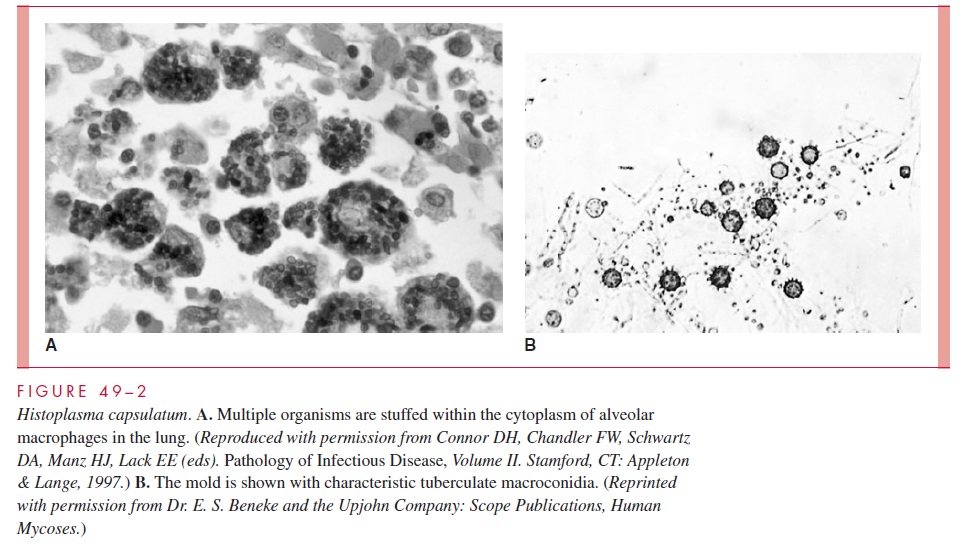Chapter: Medical Microbiology: An Introduction to Infectious Diseases: Cryptococcus, Histoplasma, Coccidioides, and Other Systemic Fungal Pathogens
Histoplasma capsulatum
HISTOPLASMA
Histoplasma capsulatum
Histoplasma capsulatum is a dimorphic fungus that grows in the yeast phase in tissue(Fig 49–2A) and in cultures incubated at 37°C. The mold phase grows in cultures incu-bated at 22 to 25°C and as a saprophyte in soil.

The yeast forms are small for fungi (2 to 4 μm) and reproduce by budding (blastoconidia). The mycelia are septate and produce microconidia and macroconidia. The diagnostic structure is termed the tuberculate macroconidium because of its thick wall and radial, finger-like projections (see Fig 49–2B).
Growth is obtained on blood agar, chocolate agar, and Sabouraud’s agar, but may take many weeks. A sexual stage has now been discovered (Ajellomyces capsulatum), but the asexual name continues to be used in the medical literature. The designation H. capsulatum is actually a misnomer, because no capsules are formed. It comes from the halos seen around the yeasts in tissue sections, which are caused by a shrinkage artifact of routine histologic methods.
DIMORPHISM
The morphologic and physiologic events associated with conversion from the mold to the yeast phase of H. capsulatum have been extensively studied. They are understand-ably complex given the dramatic change of milieu encountered by the fungus when its mold conidia float from their soil habitat to the pulmonary alveoli. Conversion to the yeast phase is then triggered by the host temperature (37°C) and possibly by other as-pects of the new environment. In vitro studies show that the earliest events in this shift from the mold to yeast form involve induction of the heat shock response and uncou-pling of oxidative phosphorylation. These are followed by a shutdown of RNA synthe-sis, protein synthesis, and respiratory metabolism. The cells then pass through a metabolically inactive state, emerging with enhanced enzymatic capacities involving sulfhydryl compounds (eg, cysteine, cystine) that are exclusive to the yeast stage. In the yeast stage, there is recovery of mitochondrial activity and synthetic capacity, but a new constellation of oxidases, polymerases, proteins, cell wall glucans, and other com-pounds are present.
Dimorphism in fungi is reversible, a feature that distinguishes it from developmental processes such as embryogenesis seen in higher eukaryotes. The importance of the con-version to virulence of Histoplasma is shown by animal studies using strains biochemi-cally blocked from converting to the yeast phase. They neither produce disease nor persist in the host. To the extent known, these features are similar in the other dimorphic fungi.
Related Topics